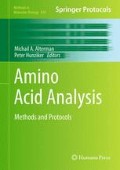Abstract
Amino acid analysis is among the most accurate methods for absolute quantification of proteins and peptides. Here, we combine acid hydrolysis with the addition of isotopically labeled standard amino acids and analysis by mass spectrometry for accurate and sensitive protein quantitation. Quantitation of less than 10 fmol of protein standards with errors below 10% has been demonstrated using this method (1).
Access this chapter
Tax calculation will be finalised at checkout
Purchases are for personal use only
References
Mirgorodskaya OA, Körner R, Novikov A, Roepstorff P (2004) Absolute quantitation of proteins by a combination of acid hydrolysis and matrix-assisted laser desorption/ionization mass spectrometry. Anal Chem. 76:3569–3575
Berggren K et al (2000) Background-free, high sensitivity staining of proteins in one- and two-dimensional sodium dodecyl sulfate-polyacrylamide gels using a luminescent ruthenium complex. Electrophoresis 21:2509–2521
Ong SE et al (2002) Stable isotope labeling by amino acids in cell culture, SILAC, as a simple and accurate approach to expression proteomics. Mol Cell Proteomics 1:376–386
Mirgorodskaya OA et al (2000) Quantitation of peptides and proteins by matrix-assisted laser desorption/ionization mass spectrometry using 18O-labeled internal standards. Rapid Commun Mass Spectrom 14:1226–1232
Stemmann O et al (2001) Dual inhibition of sister chromatid separation at metaphase. Cell 107:715–726
Lange V et al (2008) Selected reaction monitoring for quantitative proteomics: a tutorial. Mol Syst Biol 4:1–14
Macchi FD et al (2000) Amino acid analysis, using postcolumn ninhydrin detection, in a biotechnology aboratory. Methods Mol Biol 159:9–30
Shevchenko A et al (1996) Mass spectrometric sequencing of proteins from silver-stained polyacrylamide gels. Anal Chem 68:850–858
Author information
Authors and Affiliations
Corresponding author
Editor information
Editors and Affiliations
Rights and permissions
Copyright information
© 2012 Springer Science+Business Media, LLC
About this protocol
Cite this protocol
Mirgorodskaya, O.A., Körner, R., Kozmin, Y.P., Roepstorff, P. (2012). Absolute Quantitation of Proteins by Acid Hydrolysis Combined with Amino Acid Detection by Mass Spectrometry. In: Alterman, M., Hunziker, P. (eds) Amino Acid Analysis. Methods in Molecular Biology, vol 828. Humana Press, Totowa, NJ. https://doi.org/10.1007/978-1-61779-445-2_11
Download citation
DOI: https://doi.org/10.1007/978-1-61779-445-2_11
Published:
Publisher Name: Humana Press, Totowa, NJ
Print ISBN: 978-1-61779-444-5
Online ISBN: 978-1-61779-445-2
eBook Packages: Springer Protocols

